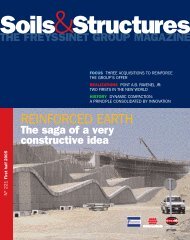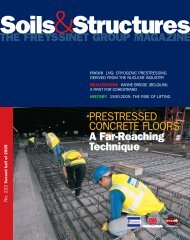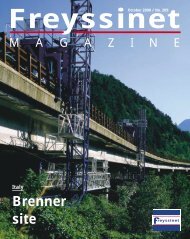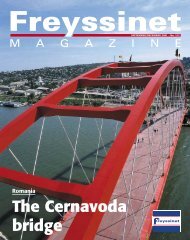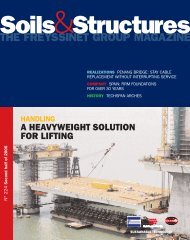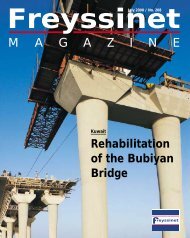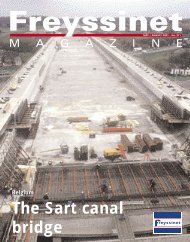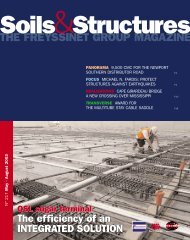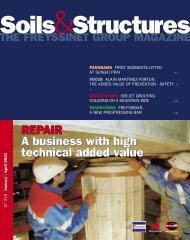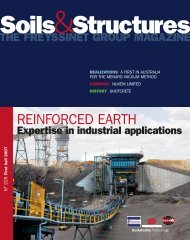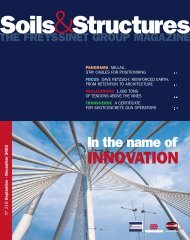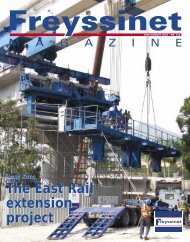STAY CABLE : The System in Top Form N°220 - Freyssinet
STAY CABLE : The System in Top Form N°220 - Freyssinet
STAY CABLE : The System in Top Form N°220 - Freyssinet
Create successful ePaper yourself
Turn your PDF publications into a flip-book with our unique Google optimized e-Paper software.
FOCUS<br />
structures that were<br />
large, <strong>in</strong>terest<strong>in</strong>g and<br />
<strong>in</strong>novative were built,<br />
but these have not aged<br />
well. <strong>The</strong> second phase<br />
was characterized by<br />
a less-selective use of<br />
the technique; This gave<br />
rise to the construction<br />
of very <strong>in</strong>terest<strong>in</strong>g<br />
structures, but also<br />
of ones that are more<br />
questionable. Lastly,<br />
the third and current<br />
phase benefits from<br />
high-quality stay cables<br />
and auxiliary elements,<br />
thus permitt<strong>in</strong>g the<br />
creation of durable,<br />
easy-to-ma<strong>in</strong>ta<strong>in</strong><br />
structures. <strong>The</strong> result<br />
has been real progress<br />
<strong>in</strong> the areas of<br />
watertightness, anti-UV<br />
protection, vibration<br />
control, and the high<br />
durability of<br />
<strong>in</strong>dividually-protected<br />
strands, etc. Stay cables<br />
are no longer used<br />
exclusively for structural<br />
or aesthetic reasons, but<br />
now, thanks to these<br />
steps forward, can serve<br />
as very <strong>in</strong>terest<strong>in</strong>g<br />
functional and<br />
architectural objectives.<br />
<strong>The</strong>ir use can become<br />
truly active and effective.<br />
Miguel Gomez Navarro.<br />
Is the design of a cablestayed<br />
structure like that<br />
of any other structure<br />
<strong>The</strong> use of stay cables<br />
requires the design of<br />
structures that could be<br />
qualified as “aerial”;<br />
<strong>The</strong>se pass over<br />
functional zones at great<br />
heights, and are<br />
necessary when the goal<br />
is to completely free<br />
up the lower space of a<br />
site. In addition, it’s<br />
important to remember<br />
that, besides provid<strong>in</strong>g<br />
support, stay cables<br />
are great aids dur<strong>in</strong>g<br />
construction.<br />
Structurally speak<strong>in</strong>g,<br />
when used on large<br />
constructions, they offer<br />
great freedom of design<br />
and <strong>in</strong>stallation. Such<br />
characteristics are the<br />
result of developments<br />
<strong>in</strong> digital analysis and<br />
computers.<br />
If modern architecture<br />
is to be regarded as<br />
complex, it’s because<br />
these tools are available,<br />
are used <strong>in</strong> an <strong>in</strong>creas<strong>in</strong>g<br />
number of applications,<br />
offer more possibilities<br />
and new solutions.<br />
In the framework of this<br />
<strong>in</strong>creas<strong>in</strong>gly active use<br />
of stay cable elements <strong>in</strong><br />
architecture, we believe<br />
that parallel strand<br />
cables have more design<br />
potential and a larger<br />
range of applications<br />
than locked-coil strands,<br />
which are more limited<br />
to suspended structures<br />
and <strong>in</strong>dustrial uses.<br />
Locked-coil strands<br />
are less ductile under<br />
current civil eng<strong>in</strong>eer<strong>in</strong>g<br />
recommendations.<br />
What do you believe<br />
the future holds for<br />
cable-stayed structures<br />
Though current stay<br />
cable technology is<br />
satisfactory, we foresee<br />
cont<strong>in</strong>u<strong>in</strong>g progress <strong>in</strong><br />
the quality of materials<br />
and elements mak<strong>in</strong>g up<br />
steel stay cables. We are,<br />
however, more skeptical<br />
about the development<br />
of composite materials<br />
<strong>in</strong> the short term,<br />
except <strong>in</strong> very particular<br />
cases such as that<br />
of the Collserola<br />
Telecommunications<br />
Tower. Here, steel stay<br />
cables were used for<br />
the lower section and<br />
composite Kevlar cables<br />
were used for the upper<br />
section to stabilize<br />
the mast (because metal<br />
pieces would have<br />
generated <strong>in</strong>duction<br />
currents and, thus,<br />
could not be <strong>in</strong>stalled).<br />
Because of their cost<br />
and conditions of use<br />
demand for these<br />
materials will not<br />
become widespread<br />
rapidly, and their use<br />
will rema<strong>in</strong> limited to<br />
specific applications.<br />
For the design of<br />
bridges, we could<br />
perhaps use mixed<br />
<strong>The</strong> Collserola<br />
Telecommunications<br />
Tower <strong>in</strong> Spa<strong>in</strong> comb<strong>in</strong>es<br />
the use of steel stay<br />
cables (supplied and<br />
<strong>in</strong>stalled by Freyss<strong>in</strong>et)<br />
<strong>in</strong> the lower section with<br />
Kevlar cables <strong>in</strong> the upper<br />
section to avoid disruption<br />
of radio broadcast<strong>in</strong>g.<br />
<strong>The</strong> cables of the Valladolid<br />
Science Museum footbridge<br />
serve both as stay cables<br />
and prestress<strong>in</strong>g elements.<br />
solutions <strong>in</strong> the future<br />
to surpass the current<br />
limits. In our op<strong>in</strong>ion,<br />
however, the current<br />
traditional criteria,<br />
with a few m<strong>in</strong>or<br />
improvements, will<br />
cont<strong>in</strong>ue to decisively<br />
dom<strong>in</strong>ate the market<br />
for years to come. n<br />
* Also see page 18.<br />
Second semester 2004 Soils & Structures 5



